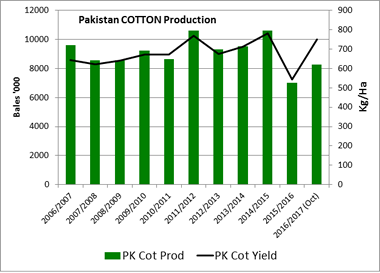Pakistan Cotton Conditions Improve
Pakistan cotton production for 2016/17 is forecast at 8.25 million 480-pounds bales (mb), up 0.25 mb from last season. The increase in the year-to-year production estimate is driven by an expected recovery in yield to 748 kilograms per hectare (kg/ha). Area is estimated at 2.4 million hectares (mha), down 0.1 mha from last season. The lower area this year is largely a reflection of the lower prices at planting for cotton relative to other crops at the time. An increase in sugarcane area offset the decrease in cotton.

Source: USDA

Source: USDA
Cotton prices, however, have strengthened significantly since planting. According to USDA’s Office of Agricultural Affairs in Islamabad, seed cotton prices are now $0.37 US per pound, compared to $0.25 US per pound a year ago. Although the now-higher prices could not affect decisions at planting, they are expected to prompt cotton farmers to invest more in inputs, insecticides and labor. By comparison, the low 2015/16 cotton prices resulted in farmers reducing costs by curbing pesticide applications, leading to exceptionally damaging outbreaks of whitefly and leaf curl virus that resulted in record low yields. Final production depends on multiple pickings during harvest. To conduct multiple pickings, farmers must decide on how much to invest in both inputs and labor, and the recent increase in prices encourages these investments and yield is expected to increase significantly compared to last season.
Cotton is grown primarily in Punjab and Sindh provinces. On average, Punjab produces about 75 percent of the crop and Sindh 25 percent.

SEASON TO DATE
In Sindh province cotton is sown during March and April,while in Punjab most sowing activities take place during May and June. This season some late sowing continued up to the end of June. As an irrigated kharif (summer) crop, widespread monsoon rainfall benefitted cotton by recharging irrigation supplies this year though some areas were reported to have excessive moisture. Punjab seasonal precipitation thus far is slightly above normal.

In Sindh province, precipitation during the growing season has been below normal, but irrigation water is in ample supply.

In areas of prolonged wetness there is a potential threat of insect pest multiplication. As expected, some hotspots of white fly and boll worm have been noted in parts of Punjab. Reports of pest infestation, however, have remained isolated, and growers have successfully managed to control any outbreaks. September is generally the most crucial month for the cotton crop. Below-average temperatures and high humidity during the past several years were conducive for insect pressure, and farmers need to remain vigilant in monitoring for pest outbreaks. Overall, growers have reported good crop conditions showing a satisfactory number of bolls. Picking has begun in Sindh province and seed cotton prices remain attractive. The peak harvest for Pakistan typically occurs during October as picking moves northward into the major cotton producing districts of Punjab province.
From August through September, mainly hot and dry conditions persisted across most of the cotton growing areas. The Pakistan Meteorological Department’s short-term forecast is that similar conditions will continue across much of the region. Growers remain pleased with the recent dry weather, and the crop is approaching maturity in many areas. The next few weeks will remain crucial for crop development, and growers would not welcome any heavy rains during this period. Reports of pest infestations have largely remained isolated and growers have remained vigilant to ensure that any outbreaks are dealt with. Harvesting and seed cotton arrivals virtually halted during mid-September due to the extended Eid holidays, but deliveries and ginning activity are expected to resume quickly and should reach a peak during October.
Current USDA area and production estimates for grains and other agricultural commodities are available on IPAD's Agricultural Production page or at PSD Online.
Visit Crop Explorer http://www.pecad.fas.usda.gov/cropexplorer/
|

